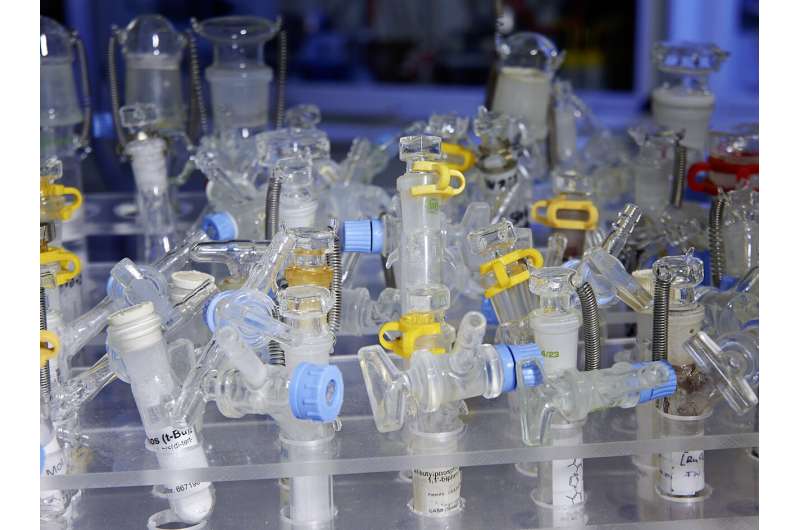New air- and water-sensitive catalysts are produced and stored in so-called Schlenk vessels under an inert gas atmosphere. Credit: LIKAT/Nordlicht
What people ingest is broken down biochemically by the organism in the metabolism: valuable substances are digested, less essential ones are discarded and excreted. In the case of drugs, this degradation sometimes begins before they can fully develop their healing effect.
Chemists try to prevent this by replacing atoms of hydrogen (H) in the drug molecule with deuterium (D), an isotope of hydrogen. In her dissertation at the Leibniz Institute for Catalysis (LIKAT), a young researcher explored how this isotope exchange can be carried out more simply, resource-efficiently and cost-effectively than before.
2017: First deuterated drug
Chemically, hydrogen and deuterium are identical. Deuterium only has a heavier atomic nucleus. "That's why it reacts more slowly than hydrogen," explains Dr. Sara Kopf from LIKAT. "And it is precisely this 'inertia' that stabilizes drugs, for example. That is, the degradation by the organism is delayed." In the future, patients could be treated with lower doses than before and risk fewer side effects.
The first deuterated drug was approved by the U.S. Food and Drug Administration (FDA) in 2017. It alleviates movement disorders in the treatment of Huntington's disease. Since then, laboratories around the world have been trying to achieve more stable medical agents through hydrogen isotope exchange. Sara Kopf also chose the topic, in 2020 for her dissertation, which she defended in November.
The goal of this work, which was supervised by LIKAT Director Prof. Dr. Matthias Beller: to greatly simplify the chemical process of deuteration. This included on one hand, the catalyst, and on the other, the source for the deuterium.
Source: Deuterated water
Kopf chose deuterated water as a new source. Unlike the deuterium gas that is usually used, it can be processed under normal pressure and is cheaper.
One of the tricks of deuteration is not to replace all the H atoms in the molecule, but only selected ones, explains the chemist. Suitable locations would be, above all, so-called C-H groups. These consist of one carbon atom (C) and up to three hydrogen atoms (H) and are very common in pharmaceuticals. For chemists, they are the preferred reaction site in the molecule: so-called C-H activation can be used to specifically endow active ingredients with functions.
This C-H activation is one of the dream reactions in organic chemistry, as Dr. Kopf says, "Very attractive, but difficult to master. We use it to cleave the C-H group and replace the H atom with other elements. And, of course, it lends itself to replacing hydrogen with deuterium."
Catalysts: Manganese and ruthenium
This C-H activation requires a catalyst, usually iridium, an expensive precious metal, rarer than gold and platinum. Sara Kopf also wanted to find alternatives for this. She experimented with ruthenium and manganese. "Ruthenium is more abundant than iridium, is well researched and offers a lot of literature in terms of C-H activation," the chemist says. Manganese exists in large deposits, is similar in properties to iron, is similarly inexpensive, non-toxic, and is increasingly coming into focus among experts because it opens a path toward "green chemistry."
The experiments got off to a slow start, recalls Sara Kopf. What worked effortlessly with iridium did not work with ruthenium or manganese. Only with a co-catalyst did the breakthrough come. In mechanistic analyses, she identified what happens molecularly in the reaction. The crux of the matter turned out to be that the C-H groups that the chemist had intended for the isotope exchange did not come close enough to the catalyst to be able to react.
Universal method
"The trick is to use other structures in the molecule as conductors, so to speak, which bring together the corresponding C-H groups and the catalyst." In her dissertation, Sara Kopf describes how typical structures in organic chemistry molecules can be transformed into conducting groups. Those who were once good at chemistry will still know the names from class: e.g., ketones (C-O), which consist of one carbon and one oxygen atom, or aldehyde groups (C-H-O) made of carbon, hydrogen and oxygen.
Dr. Kopf says, "The more groups I can access as conductors in the molecules, the more pharmaceuticals I can then 'label' using deuterium." This makes the new isotope exchange method suitable for broad fields of application. However, further research is needed to make it ready for practical use, he said. For example, Dr. Kopf's method still claims temperatures between 100 and 120 degrees Celsius. "There are structures in the molecule that cannot withstand this heat. For the reaction, 40 degrees or even room temperatures would be ideal."
After two and a half years of research, Sara Kopf defended her dissertation with the highest possible grade, summa cum laude. She published an overview article on her research topic in the journal Chemical Reviews.
More information: Sara Kopf et al, Recent Developments for the Deuterium and Tritium Labeling of Organic Molecules, Chemical Reviews (2022). DOI: 10.1021/acs.chemrev.1c00795
Journal information: Chemical Reviews
Provided by Leibniz-Institut für Katalyse
























